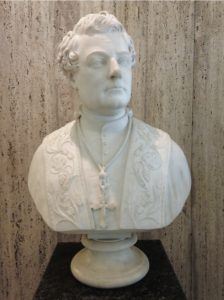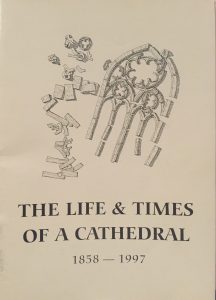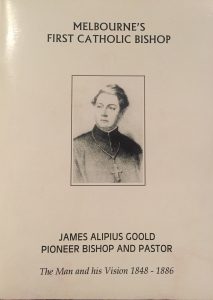Reintroducing Archbishop James Alipius Goold
Rev Dr. Max Vodola, University of Divinity
In 1997, St Patrick’s Cathedral, Melbourne, celebrated its centenary. The diocese had come a long way since 1847 when the Augustinian priest, James Alipius Goold (Figure 1), arrived in Melbourne and became its first Catholic bishop (1812-86). At that time, Melbourne was a provincial town and Goold was enthroned in his cathedral church, St Francis’. In less than a decade, the city of Melbourne and the colony of Victoria were greatly transformed by the gold rush. Goold was faced with increased demands for churches and schools, priests and religious, to keep up with the growing needs of the colony. St Francis’ in Lonsdale St quickly outgrew its capacity and Goold dreamed big dreams for a splendid new cathedral on Eastern Hill to match the increased status and dignity of Melbourne as a major international metropolis.

The foundation stone for St Patrick’s Cathedral was laid in 1858 and Goold secured the services of the brilliant architect William Wardell. The pile of bluestone slowly grew in size on Eastern Hill, not without drama and controversy over design issues, labour shortages and costs blowouts. Goold died in 1886 and it was for his successor, Archbishop Thomas Joseph Carr, to officially bless and open the near-completed cathedral in 1897. Carr’s successor, Daniel Mannix, made the daring decision in post-depression Melbourne to complete the spires of the cathedral in the late 1930s. Much of the cathedral remained unchanged until the internal reordering mandated by the Second Vatican Council (1962-65).

By 1997 a major internal and external refurbishment was demanded in order to celebrate the cathedral’s centenary and to launch its next century of life. In order to draw attention to the cathedral’s history and value its rich cultural patrimony, a series of exhibitions were planned as an off-shoot of the major fundraising work of the Cathedral Centenary Committee. The work of arranging, supervising and directing the exhibitions was placed in the capable hands of the late Fr John Patrick Rogan (1941-2000). St Patrick’s Cathedral had no greater friend.
John Rogan (Figure 2) was born in Melbourne in 1941. He was educated by the Sisters of the Good Samaritan in Thornbury and then by the Christian Brothers at St Thomas’ Clifton Hill and Parade College, East Melbourne. John studied law at Melbourne University and practiced for ten years. It was during this time that he developed an interest in fine arts and became involved with the National Trust. John’s next career was with Kozminsky’s in Bourke St where he was business manager for ten years. He came to know the world of jewellery, paintings and antiques and became a respected contact across the nation and a natural ‘go to’ person. In 1975, he published Antiques in Australia from Private Collections.
In 1986, John embarked on the third and most significant phase of his life when he entered Corpus Christi College, Clayton, to begin his studies for the priesthood. He was given the choice to either study in Melbourne or attend the ‘late vocations’ seminary in Sydney. John chose to stay in Melbourne, to the eternal gratitude of his friends and colleagues. John gave himself enthusiastically to his studies, his pastoral work and student life in the college. It was during this time that John helped form the ‘Friends of Corpus Christi College Library’ and became a member of the Melbourne Diocesan Historical Commission. John became greatly interested in the history of the diocese and its extraordinary cultural patrimony.
John was ordained to the priesthood in August 1992. He served in the parishes of Essendon, Seaford and Greensborough before taking up his appointment as assistant priest and St Patrick’s Cathedral. He came to know and love the cultural, not just as a cultural monument, but as a living, breathing, place of worship and ceremony. John quickly set about forming an exhibition sub-committee of willing volunteers and fellow enthusiasts. John was a man of remarkable energy, vision, grace, charm and style. In preparing the four major exhibitions, it was John who first called attention to Goold as ‘collector’. Like Goold, John Rogan had a fine eye for detail. In preparing for the exhibitions, he would call attention to the particular significance of a book, a painting, a chalice, a set of vestments or other liturgical item.

The first exhibition in April 1997 was titled ‘St Patrick’s Cathedral and William Wardell; the man, his plans, his life and times’ (Figure 3).
John curated each exhibition and compiled and edited the majority of catalogues. The style was simple and modest but the detail was simply exceptional. Architectural historian and Wardell expert Dr Ursula de Jong wrote the catalogue essay and text. She drew attention to the background of Wardell, the influence of Pugin, the features of neo-Gothic in the context of colonial Australia and the distinctive internal and external features of St Patrick’s Cathedral. The beauty of the cathedral only made sense when seen in the context of Melbourne’s other great architectural marvels – St Paul’s Cathedral, Parliament House, the Treasury Building, Government House and the Royal Exhibition Building. Many of Wardell’s designs for the cathedral were displayed for the first time to the general public. Books, letters, photographs and personal items were exhibited, all displayed with John’s typical sense of style, elegance and perspective. A particularly impressive and eye-catching part of the exhibition was John’s ‘re-creation’ of Wardell’s nineteenth century office and workroom featuring desk, crucifix, drawing instruments, inkstand, spirit decanters and tobacco box. The architect and the man came to life before our very eyes.

The next exhibition in July 1997 was titled ‘The Life and Times of a Cathedral 1858-1997’ (Figure 4). It told the rich story of the cathedral from the aborted earlier attempts of Samuel Jackson and George & Schneider, the dreams of Goold, the vision of Wardell, the cost, the heartache and the many disputes. One true hero emerged from the shadows, Dean John Fitzpatrick; administrator, fund-raiser and faithful labourer in the vineyard of the Lord. The other heroes were the generous faithful from across Victoria who constantly donated to the cause of the cathedral even when there grumblings about Goold’s spending. Each bishop featured in the story of the cathedral with personal items, photographs, vestments, books, letters, illuminated addresses, chalices and ecclesiastical furniture. Catholic life in the past was remembered in terms of St Patrick’s Day processions and lay sodalities with their banners. Attention was called to the fine detail in each of the back chapels that circle the sanctuary, the cathedral bells and the rich musical tradition over one hundred years. Important events were commemorated such as the 1948 centenary of the diocese of Melbourne, the 1973 International Eucharistic Congress, the conferring of the title ‘Minor Basilica’ by Pope Paul VI in 1974 and the 1986 Papal Visit of John Paul II.

In October 1997, John launched perhaps the most daring, stylish and imaginative exhibition of the centenary. He conceived of the cathedral nave becoming a great exhibition space that combined exquisite floral displays with the best and finest ceremonial embroidery in the collection of the Melbourne Diocesan Historical Commission (Figure 5). The view was simply breath-taking. Sumptuous floral displays funded by generous donors and benefactors combined with elaborate showing of copes, chasubles, dalmatics, preaching stoles, processional canopies, ceremonial banners and other liturgical items. Cathedral florist Alan Steele was Festival Director working with the Floral Art Society of Victoria.
John had spent a considerable amount of time putting together detailed inventories of the vestments. Many were in poor condition but of immense historical significance. John formed an alliance with Embroiderers Guild of Victoria. They willingly gave their time and expertise to the restoration of ceremonial items. It was a true labour of love. The spring festival of flowers truly gave glory to the Creator in an astonishing display of beauty. The displays invited participation not just from Catholics but from far and wide across the community which was testament to John’s great networking skills and the energy and agility of committee members. But the displays also called for reflection on the life of faith and participation from the next generation of Catholic believers. The exhibition catalogue featured a letter from the students of Mary Immaculate School in Ivanhoe:
Dear St Patrick’s Cathedral, this donation was raised so as to decorate or Lady’s Chapel number 11 with flowers in October. Mary Immaculate Primary School raised $267.35 in total. We raised this money by having a blue clothes day.

At this stage of the centenary year, sheer exhaustion had enveloped all and sundry, but more themes were to be examined in detail. St Patrick’s Cathedral was only possible because of the vision, energy and tenacity of Goold. One final exhibition would pay tribute to this legacy and so it came to birth; ‘James Alipius Goold – Pioneer Bishop and Pastor; The Man and his vision 1848-1886’ (Figure 6). In addition to the centenary of the cathedral this exhibition would commemorate the 150th anniversary of Goold’s arrival in Melbourne. For the record, John stated that it was the then Dean of St Patrick’s Cathedral, Monsignor William McCarthy, who suggested the idea of an exhibition on Goold in the context of the parishes and religious of his episcopate.
In addition to the collection of the Melbourne Diocesan Historical Commission, John and the committee worked diligently with numerous parishes and religious orders for items to be loaned that reflected Goold, his times and the diocese that he pastored. Books, letters, documents, paintings, furniture, vestments, ecclesiastical plate and domestic silverware all featured in the exhibition. There was a renewed focus on Goold’s Irish background, his Augustinian training and his experience as a student in Rome and Viterbo where he undoubtedly acquired a taste for baroque art. The exhibition drew attention to the growing needs of the diocese, the need for schools and the interaction with religious orders who came to Melbourne. Much was made of Goold’s purchases of books and artwork on his trips overseas and the destination of these paintings following his return to parishes, schools and convents across Victoria. There was renewed focus on Goold’s membership on the University of Melbourne Council, his donation of works to the National Gallery of Victoria and his contribution to the International Exhibition of 1869. As St Patrick’s Cathedral rose in splendour on Eastern Hill and the diocese greatly expanded in terms of churches, schools, clergy, religious and faithful, behind the scenes Goold often consulted his episcopal uncle, Bishop John Thomas Hynes (1799-1869), Vicar Apostolic of Demerara, British Guiana, for advice of numerous matters in the workings of the diocese.
The Australian Research Grant (ARC) awarded by the Commonwealth on 1 November 2016, A Baroque Archbishop in Colonial Australia: James Goold 1812-1886, is the joint effort of Chief Investigators Professor Jaynie Anderson, distinguished international art historian and Mr Shane Carmody, Senior Development Manager, University of Melbourne Library and Rev Dr Max Vodola, lecturer in Church history at Catholic Theological College (University of Divinity) and Chairman of the Melbourne Diocesan Historical Commission. This project will conduct original research in new fields of interdisciplinary study of Goold as ‘cultural patron’ of the diocese of Melbourne, especially in his artwork, his library and the commissioning of William Wardell. This research has international significance. The exhibitions in 1997/98 associated with the centenary of St Patrick’s Cathedral began to reinterpret the significance of Goold as a collector and the importance of the cultural patrimony of the archdiocese of Melbourne that communicate something essential in the transmission of the story of the Catholic faith in Australia. The exhibitions enabled a wider audience to come to know Goold in a far more visually enriching way than was possible from the written word of his entry in the Australian Dictionary of Biography and works by Frances O’Kane and Margaret Pawsey.
As the exhibitions were largely inspired by the vision of the late Fr John Rogan, we will let John have the final word in terms of his work being a launching pad to a renewed interest in Goold, his times, his collecting and the material culture he was able to transmit in the lived reality of Catholic life in colonial Australia. John Rogan wrote the following entry at the conclusion of the catalogue of the final exhibition held in 1998 to commemorate the 150th anniversary of Goold’s to Melbourne:
“As you reach the end of this Exhibition, focusing on the life and times of James Goold, pause briefly to enjoy his greatest gift in stone and mortar, St Patrick’s Cathedral, in which you now stand. The possession of such an architectural gem within the city is not only for the benefit of Roman Catholics, but also enhances Melbourne as a place to live and visit. It is surely a place of great beauty, but it is also a refuge of spiritual sustenance, nurturing all who seek solace; this is at the heart of the building’s identity. The Cathedral is a prayerful setting for praise and liturgical celebration; in it, the elements of stone and glass, artistry and craftsmanship, colour and sound coalesce to filter the divine presence of the Creator God. The language of Christian symbol and metaphor is made accessible to all who seek understanding. In this Cathedral, we give thanks for the life and legacy of James Alipius Goold, Bishop and Pastor and a man of vision.”
John P. Rogan
September 1998
Categories